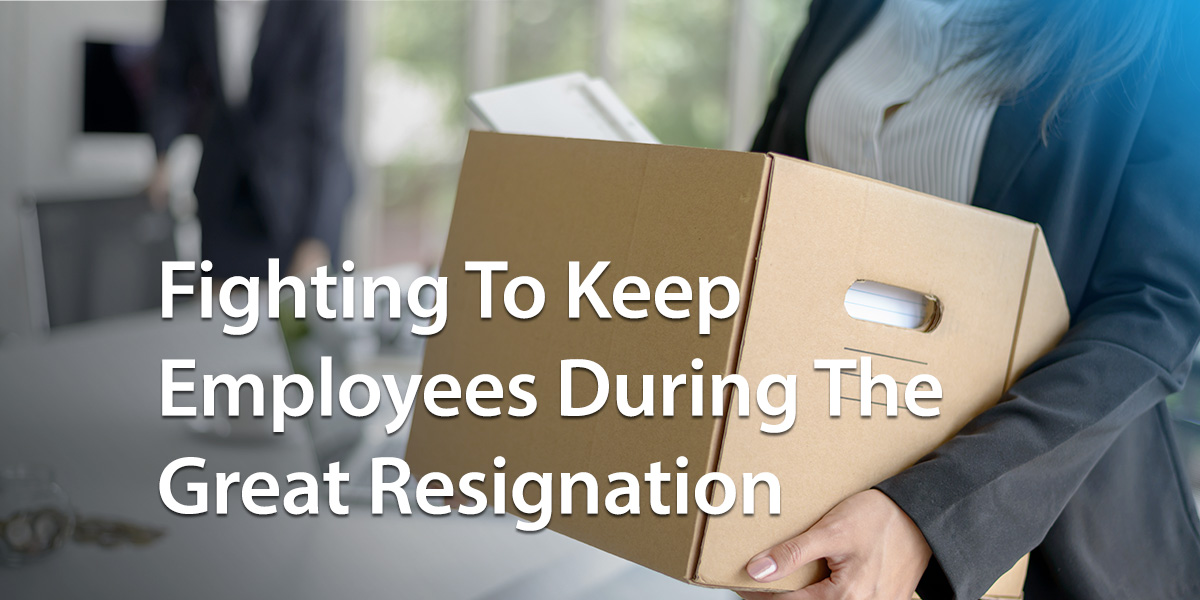The pandemic-led tsunami of the so-called Great Resignation is still rumbling along. In the past year, more than 4 million Americans quit their jobs every month. There’s no doubt employees are restless. Furthermore, the impact of employee churn is made worse by the talent shortage apparent globally and in corporate America. According to one survey, 69 percent of employers struggle to find top talent.
This post is essential reading if you want to stem the tide in your organization. We take a deep dive into the Great Resignation. We look at what’s driving it and, more importantly, what you can do to retain employees.
What Is Causing The Great Resignation?
There’s a complex melting pot of issues at play. And while each person’s reasons for quitting will vary, there are some common themes across all job categories.
- Work-life balance: The shift to remote work during the pandemic might have been scary at first. However, once workers adjusted, they soon found the new set-up suited them and their personal obligations. And most employees want to continue with remote work or hybrid arrangements. According to research from Flexjobs, an overwhelming 97 percent desire some form of remote working. Those organizations that have ignored the desire for flexibility are paying the price with high turnover.
- Feeling undervalued: Existing employees will leave if they think their hard work is unrecognized. This is especially so for top talent. This group is more likely to resent not feeling valued by their employers. The bottom line is companies risk losing their most productive staff if they don’t recognize current employees more.
- Poor career prospects: Many workers quit because their employer fails to invest in their careers. Few opportunities for advancement and a lack of training and development impact employee retention. A new employer that promises clear career paths will entice many employees to pastures new.
- A world of opportunity: With remote work now widely accepted into mainstream culture — and services like Remote’s global employment platform making international recruitment more viable than ever — there’s never been a better time to search for a new career. Applicants are no longer limited by their physical location; if they’ve got the relevant skills, they’re in with a shot.
- Reevaluation mindset: The uncertainties of the pandemic may have prompted many employees to reevaluate their priorities. Workers who were burnt out in their current jobs may have experienced this more keenly. For example, those on the frontline of the Covid response experienced high turnover. And parents juggling caring responsibilities with home-schooled children were also affected by the change in perspective. Although the worst of the pandemic may be over, employees feel a lingering sense of restlessness as they figure out what’s important to them.
How Many People Quit In The Great Resignation?
At its height in March 2022, a record 4.5 million US workers left their jobs for reasons other than retirement.
Interestingly, some industries have been affected more than others. Perhaps not surprisingly, healthcare workers have quit their jobs in droves. And hospitality, leisure, and retail also experienced a sharp increase in their turnover rate.
Will The Great Resignation Continue In 2023?
The short answer is yes. Many commentators, including the Harvard Business Review, have speculated that the pandemic didn’t start the trend. It merely exacerbated it. Certainly, the latest data suggests that although employee churn may be in decline, retention remains a hot issue.
What Are The Cons Of The Great Resignation?
Employees quitting their jobs is inevitable. People leave for a whole variety of reasons. And bringing in new hires with fresh ideas and perspectives can be good for business.
On the other side of the coin, the loss of team members impacts overall employee productivity. All that valuable company knowledge is simply walking out the door. And the remaining staff often have to work harder to fill the gaps, impacting customer service. In this environment, employee engagement and team morale take a deep dive. You may find you have even more problems with employee burnout, creating a vicious circle.
Furthermore, hiring top talent isn’t so easy nowadays. There’s a worldwide shortage of good people. And every HR professional knows that hiring new employees costs a whole heap more than keeping existing ones.
How Businesses Can Respond To The Great Resignation
The issue isn’t going away any time soon. So, what can your business do about it?
The good news is there are steps companies can take to boost retention. And it’s really quite simple. The best way to fight the Great Resignation is by changing how you treat the workers who stay. Here are some steps you can take to do just that. Spoiler alert here – it’s not all about pay and money.
Motivate Employees With Career Transparency
Employees want managers who are supportive of their careers. They want to see a clear career pathway and opportunities to develop new skills. When a worker has a good relationship with their manager and can see growth opportunities, they feel valued. And there’s little incentive to look elsewhere.
So, look to nurture and grow your internal talent. And remember, not everyone wants to climb the corporate ladder. Many just want the chance to try something new or have a fresh challenge without a promotion. Lateral job moves, stretch assignments or cross-team collaborations are perfect ways to satisfy that need.
A Job Title Isn’t The Most Important Part Of An Employee’s Identity
For too long, employers have focused on what people do rather than who they are. However, your people are so much more than their job titles. They are parents, caregivers, investors, homeowners, tenants, pet owners and much more.
Companies need to rethink their workplace culture to acknowledge the whole person. Rather than a one-size-fits-all solution, think about work schedule flexibility that fits the individual employee’s needs. And diversity and inclusiveness policies acknowledge and promote individuality.
A worker that’s appreciated as an individual rather than a cog in the wheel feels valued. Employee loyalty and company culture are boosted, which in turn powers up talent retention.
Invest In Taking Care Of Your Employees And Their Families
As we have seen, employees are more than just workers. And increased loyalty is the natural byproduct when an employer offers support to the individual and their families. Flexible work schedules that address employees’ caring responsibilities and a better work-life balance are obvious solutions.
However, mental wellbeing took on new meaning during the stress and strain at the pandemic’s peak. Looking after employees’ mental health benefits the individual and their families. Workplace mindfulness, yoga, health checks, and paid time off are fantastic ways to show you care about your people.
Another possibility is financial health programs. The cost-of-living crisis is being felt throughout the world. Employers can do their bit by offering advice and support on retirement plans, health, and life insurance or savings programs.
Employee Hiring Aligned With Company Culture And Company Core Values
Ensuring your future employees align with the organization’s culture and values saves a lot of hassle further down the track. Work out the key attributes and attitudes you want in your people. Expand your circle of potential candidates and ensure new hires tick all the boxes for cultural fit. Clarity makes it easier to set the right expectations from day one.
Once you have jumped that hurdle, the next one to tackle is a robust onboarding process. Use onboarding to reinforce a sense of your company values and culture. Paint the bigger picture and how the worker contributes.
Onboarding is a vital tool in the quest to retain more employees. A stronger commitment to the company enhances job performance and increases loyalty.
Leadership Support And Employee Recognition
Managers play a vital role in enticing employees away from scrolling through job boards. According to the old saying, workers quit their managers, not their employers.
A good, supportive relationship between managers and their direct reports is critical. So too, is a culture of employee recognition. A thank you from the leadership for a job well done motivates employees, spurring them on to achieve even more. And don’t forget peer-to-peer recognition. Celebrate wins with company shout-outs or employee of the month programs. And make employee recognition an everyday part of your workplace.
Conduct Employee Surveys
The Great Resignation has shown us that companies should listen to employees more. Employee feedback is key if your organization is serious about the fight to retain workers. Listening to the workforce demonstrates how much the business values and appreciates employees. Useful tools here include employee surveys, pulse checks, Q&A sessions with the leadership, and town hall meetings.
And be sure to act on the feedback received. All talk and no action are counterproductive. Your hard work will be undone if you don’t respond to what employees tell you.
Will The Great Resignation Create The Great Pay Gap?
Finally, a word about pay. In their efforts to hang on to the workforce, some organizations may create a future problem.
Workers that threaten to quit are often enticed to stay with counteroffers, salary hikes, or extra bonuses. Word soon gets out on the office grapevine. And resentment and frustration set in with loyal coworkers on lower salaries. It’s potentially a toxic situation that could derail your retention efforts.
Right now, many companies are willing to do whatever it takes to recruit the brightest and the best. So, if you are one of those companies that have stretched salary guidelines, now’s the time to take a step back. Many experts are warning you could end up with massive pay gaps.
Possible solutions include one-off loyalty bonuses for current workers. Others argue for more regular salary reviews than the traditional annual discussion. These offer hope and motivation for those workers who choose to stay the course.
Whatever you do, it’s wise to have some central oversight of compensation management. There’s value in having an organization-wide policy to guide managers’ decision making.
Is The Great Resignation Really A Thing?
The simple answer is yes, although some industries and job categories have been impacted more than others. The immediate pandemic-led wave may be over that doesn’t mean the tide has turned. The fight to keep employees during the Great Resignation continues. And the moment for action is now, so use the tips we have shared to get on top of employee retention and change your office turnover rate.
Sources
https://www.bls.gov/news.release/jolts.nr0.htm
https://go.manpowergroup.com/talent-shortage
https://www.flexjobs.com/blog/post/work-life-balance-or-better-pay-two-thirds-choose-balance
https://hbr.org/2022/03/the-great-resignation-didnt-start-with-the-pandemic
About MyHub Intranet
We are a leading provider of super simple, fully customizable intranets. Our software can help you simultaneously tackle several driving forces behind the Great Resignation. MyHub’s platform benefits you and your people, from communication to collaboration and beyond. Explore the possibilities with a free demo or 14-day trial. And check out our blog for more insights on today’s hot issues.










0 Comments